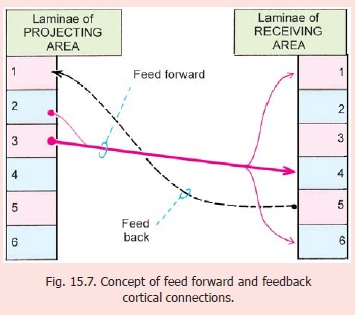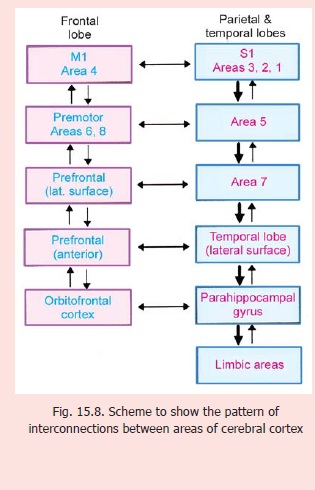Chapter: Human Neuroanatomy(Fundamental and Clinical): Further Consideration of the Cerebral Cortex
Some Features of Cortical Connections
SOME FEATURES OF CORTICAL CONNECTIONS
Recent investigations have brought to light some interesting features of cortical connections that are briefly summarised below.
Relationship of cortical laminae to incoming and outgoing fibres
The main fibres entering or leaving a given area of cortex can be described as follows.
a) Fibres projecting from one area of cortex to another are referred to as feedforwardfibres. They arise mainly inlamina 3, with some from lamina 2. They terminate mainly in lamina 4 (but also in 1, 6 and others) of the receiving area of cortex (Fig. 15.7).

b) The receiving area sends a feedback to the area of cortex from it receives a feed forward projection. These feedback fibres arise in lamina 5 (of receiving cortex) and end in lamina 1 of the cortex from which the feed forward projection was received.
c) The projections to the striatum (corticostriate fibres), to the spinal cord (corticospinal fibres), to pontine nuclei (corticopontine fibres), and to the medulla (corticobulbar fibres) all arise mainly from lamina 5 of the cortex.
d) Corticothalamic projections arise from lamina 6.
e) Major afferent fibres entering the cortex (e.g., from the thalamus; or feed forward fibres from other cortical areas) end mainly in lamina 4. Some reach laminae 1 and 6, while a few reach the remaining laminae.
Pattern of cortico-cortical connections
It has been recognised for long that cortical areas have numerous connections with other parts of the cerebral cortex. Recent investigations show that there is a pattern in these connections, and that the pattern has important physiological implications.
a. The first feature of this concept is that major sensory areas of cortex send feed forward projections to adjoining areas of cortex; and the latter in turn project to other contiguous areas. Through a series of such connections the sensory areas get connected to the limbic cortex.
b. The second feature of the concept is that main sensory areas (in the parietal, occipital and temporal lobes) are reciprocally connected to areas in the frontal lobe.
These features can be clarified by considering the connections of the primary sensory area (SI) as follows.
1. The primary sensory area (SI) sends a feed forward projection to area 5 (lying in the superiorparietal lobule). Area 5 projects to area 7 (lying further back in the parietal lobe). Area 7 projects to the temporal lobe in the region of the superior temporal sulcus. Thisregion projects to the parahippocampal gyrus which in turn projects to the limbic cortex. Note the series of steps in this scheme. Although the main connection is in the ‘forward’ direction, all connections are reciprocal (Fig. 15.8).

2. Each ‘step’ of progression (from the main sensory area) is connected to an area in the frontallobe. SI is connected to MI. Note that these areas are contiguous to one another. Step 2, represented by area 5, is connected to the premotor area. In a similar manner each ‘step’ (in the parietal and temporal lobes) is connected to an area in the frontal lobe progressively farther removed from the motor area. This would appear to indicate a close functional linking of sensory and motor regions at various levels. All connections are reciprocal.
3. As with the somatosensory area, the visual and auditory areas are also connected to the limbiccortex through a series of ‘steps’. These are also connected reciprocally to the frontal lobe.
It is, therefore, not surprising that neurons responding to somatic, visual, and auditory impulses are widely scattered in the cerebral cortex; and that these are closely linked with motor responses.
Related Topics